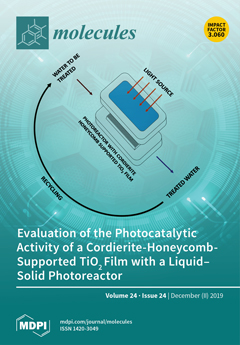In the search for new microbial antibacterial secondary metabolites, two new compounds (
1 and
2) were isolated from culture broths of
Penicillium spathulatum Em19. Structure determination by nuclear magnetic resonance and mass spectrometry identified the compounds as 6,7-dihydroxy-5,10-dihydropyrrolo[1,2-
b]isoquinoline-3-carboxylic acid
[...] Read more.
In the search for new microbial antibacterial secondary metabolites, two new compounds (
1 and
2) were isolated from culture broths of
Penicillium spathulatum Em19. Structure determination by nuclear magnetic resonance and mass spectrometry identified the compounds as 6,7-dihydroxy-5,10-dihydropyrrolo[1,2-
b]isoquinoline-3-carboxylic acid (
1, spathullin A) and 5,10-dihydropyrrolo[1,2-
b]isoquinoline-6,7-diol (
2, spathullin B). The two compounds displayed activity against both Gram-negative and -positive bacteria, including
Escherichia coli,
Acinetobacter baumannii,
Enterobacter cloacae,
Klebsiella pneumonia,
Pseudomonas aeruginosa, and
Staphylococcus aureus. Compound
2 was more potent than
1 against all tested pathogens, with minimal inhibitory concentrations down to 1 µg/mL (5 µM) against
S. aureus, but
2 was also more cytotoxic than
1 (50% inhibitory concentrations 112 and 11 µM for compounds
1 and
2, respectively, towards Huh7 cells). Based on stable isotope labelling experiments and a literature comparison, the biosynthesis of
1 was suggested to proceed from cysteine, tyrosine and methionine via a non-ribosomal peptides synthase like enzyme complex, whereas compound
2 was formed spontaneously from
1 by decarboxylation. Compound
1 was also easily oxidized to the 1,2-benzoquinone
3. Due to the instability of compound
1 and the toxicity of
2, the compounds are of low interest as possible future antibacterial drugs.
Full article






